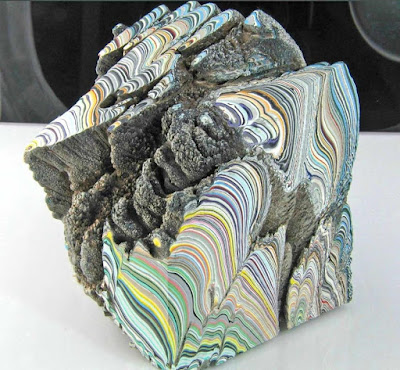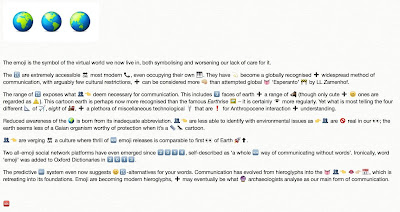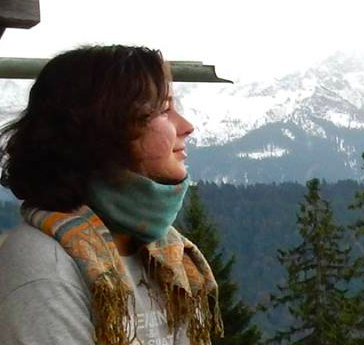“We’ve killed off the dodo, released unprecedented levels of carbon dioxide into the atmosphere, and raised sea levels: welcome to the Anthropocene, the geological age in which humankind has permanently left our mark on the planet.”
This was the description I gave to my new unit ‘The Age of the Anthropocene’, hoping to catch the attention of second year students keen to explore the impact and meaning of global environmental change. It worked: students from History, English Literature, Religion and Theology, Philosophy, Ancient History, and Study Abroad students joined me this autumn to explore how the notion of the ‘Anthropocene’ has gained traction as a definition of time that recognises the unprecedented Earth-altering impact of the human species. We engaged with debates among scientists and humanities scholars over the concept, while also exploring how it has captured popular and scholarly imagination.
One of the activities that I looked forward to was holding an inaugural Bristol ‘Anthropocene Slam’ – inspired by the original Anthropocene Slam at the Nelson Institute, Centre for Culture History and Environment (University of Wisconsin-Madison, 2014); the Anthropocene exhibition at the Deutsches Museum (Munich, 2014-16); and the BBC/British Museum initiative, ‘The History of the World in 100 Objects’. The challenge was to select an object/visual/sound that encapsulates and communicates the Anthropocene to a wide audience. Here, the students describe the unit, the Slam, and present their selection of objects which best communicate the Anthropocene to you, the public.
What is the Age of Anthropocene unit?
The Anthropocene is the notion that humanity has become a geological force in its own right, moving us in to a new epoch. Proposed by Paul Crutzen and Eugene Stoermer in 2000, it has inspired this unit ‘The Age of Anthropocene’, which explores the origins, reality and future of the changing planet. Expect hard-hitting truths about the changing relationship between humans and the environment, using the most innovative of recent scholarship, but also material and technology sources.
What is the Anthropocene Slam?
Slam! Now I’ve got your attention. For the Anthropocene slam we were each tasked with presenting a material source ranging from audio to bleach bottles, which represented our perceptions of what the broad concept of the Anthropocene meant. Our overall purpose was to present the Anthropocene with clarity, in the most effective fashion. Our broad scope reflected how the Anthropocene affects all areas of life.
Object 1: Fordite /Detroit agate
Proposed by Thecla Horton
 |
| Image via theoldmotor.com |
I chose this as an item that I think most represents the Anthropocene for a number of reasons. Fordite is layers and layers of old car paint, from when cars were hand spray-painted, which built up in the painting bays on the ‘tracks’ and ‘skids’ that cars were painted on. The colourful layers show many years of this, these layers were then ‘baked’ when the car bodies went into ovens to set the paint. This process is now extinct as cars are no longer hand sprayed.
Firstly, I think it is a good representation of the Anthropocene as a product of the automobile industry-a significant driver behind the oil industry, mass consumption, and a significant contributor to global warming. The fact that the production of this material is now extinct seems symbolic to the proposed idea that we are entering the 6th mass extinction. Technology and our world is moving so quickly that even these man made materials are becoming rare.
It looks natural and beautiful, even the name ‘Fordite/Detroit agate’ is suggestive of a natural mineral, the pattern of multiple layers making it look like it is millions of years old. Yet it is a fossil of the beginning of the Anthropocene. While fossils have taken millions of years to form, the human impact on the planet has happened so rapidly and violently to produce fossils within just a few years, and then for it also to become virtually ‘extinct’.
Object 2: Photograph of Malé, Maldives
Proposed by Toby Lane
 |
|
Image: Creative Commons/Flickr/la_camera_obscura
|
|
This is Malé, the capital of the Maldives. Situated in the Indian Ocean it is home to over 130,000 people and is the fifth most densely populated island globally. It is the world’s lowest lying nation with the islands that make up the Maldives being on average only a few feet above sea level. Sea level rise consequently jeopardises the future existence of the Maldives and the way of life for all those who live on the island.
The example of the Maldives epitomises the problems offered by the onset of the Anthropocene but also its unjust nature. Those who live on Malé have contributed little towards anthropogenic climate change but will be massively affected by the decisions and excesses of others. Furthermore the fate of Maldives is almost entirely outside of its inhabitants’ influence and the country lacks the ability to defend itself. Malé itself is only protected by a 3m high sea wall which took 14 years to construct at an expense of $63 million (99% of which was funded by Japan).
Finally, a study of the Maldives also emphasises how little time is left in order to take action on climate change if catastrophic levels of disruption are to be avoided. In April 2012 President Nasheed of the Maldives declared that “If carbon emissions continue at the rate they are climbing today, my country will be underwater in seven years.”
Object 3: Emojis
Proposed by Noa Leach
 |
| Emoji story by Noa Leach © |
Object 4: Video of a turtle (warning: scenes of an animal in distress)
Proposed by George Mumford
Object 5: Pollution mask
Proposed by Matt Davis
 |
| A man and child wear masks to visit Shanghai’s Bund. Via Creative Commons/CNN |
Since the end of the Second World War and the onset of the ‘Great Acceleration’ phase of the Anthropocene, air pollution has risen rapidly.
In the build-up to the 2008 Olympic games held in Beijing, the Chinese media became fixated on the city’s choking pollution. During an air quality crisis in February 2015, the concentration of ‘hazardous particulate matter’, known as ‘PM 2.5’, since they are 2.5 micrometers in diameter or less, rose to nearly twenty times the safe level.
Due to the health risk, many people who live in China’s major cities have started wearing pollution masks in an attempt to keep themselves safe from PM 2.5, that are small enough to seep into a person’s lungs or bloodstream. The cause of the ridiculously high air pollution has been attributed to the Chinese industrial sector as the nation’s heaviest polluters. Despite the use of pollution masks a recent report has claimed air pollution is killing around four thousand people per day in China, and accounts for one in six premature deaths.
Air pollution masks represent much about human interaction and the general consequences of the Anthropocene. It has been predicted by scientists that continued burning of fossil fuels and high pollution levels will make much of the Earth’s surface uninhabitable by the year 2100. Pollution masks represent how Beijing has arguably become the closest city yet to be rendered unfit for human habitation due to the effects of the Anthropocene, and although the government is taking action to reduce pollution, the staggering number of deaths caused already begs the question ‘are they acting too late?’ The mask also represents the human reliance upon technological remedies to the Anthropocene, a quick fix that makes the immediate threat smaller and yet fails to address the cause of the problem, that of a constant striving for economic growth, over consumption and a frame of mind that prioritises the pursuit of human progress over nature.
Object 6: Bunch of keys
Proposed by Beth Gaffney
 |
| Photographer: ©M Dudley |
This object consists of a household key chain, three different sized keys, a combination padlock, and a supermarket points fob. This object symbolises Paul Crutzen and John McNeill’s third stage of the Anthropocene: ‘The Age of the Stewards’, which marks mankind’s recognition that human activities are indeed affecting the structure and functioning of the Earth system as a whole and is filtering through to decision making. Just as a steward is an official person responsible to take care of something, mankind uses keys to lock something into a safe space. This illustrates how humans have come to acknowledge their responsibility for the earth systems, which they value for continuance of human life.
However, keys are generally forgotten about; they remain hidden in our pockets for most of the day and are often misplaced. This suggests that mankind “knows” the importance of protecting the Earth systems, but often forget to act appropriately in everyday life. Mankind’s planetary ecological consciousness has not formed.
In addition, the different sized keys illustrate how human individuals have been given various “solutions” to protect the environment. However, neither of these three keys fit into the padlock. The keys also sit alongside a plastic supermarket key fob. The solutions provided by market environmentalism often falsely legitimatize the idea that one can continue his or her consumption habits without adjustment, and no broader systematic or structural changes are required. For example, polluters pay distant others, frequently located in the global south, to engage in emission reduction activities as a substitute for reductions at the source. These solutions prioritise the western anthropogenic world and are tokenistic.
By Dr Marianna Dudley (Lecturer in Environmental Humanities), Lucy Bennett (Religion and Theology), Matt Davis (History), James Foss (History), Beth Gaffney (History), Thecla Horton (History), Lydia Hunt (Philosophy and Theology), Yejin Jeong (Study Abroad), Toby Lane (History), Noa Leach (English), Rupert Liddell (Ancient History), George Mumford (History), Roisin Murphy (History), Olivia Nathan-King (Religion and Theology), and Cassie Rist (Religion and Theology) . Thanks go to Bristol Museum Curator Bonnie Griffin for joining our workshop and sharing her expertise, and to Cabot Innovation Fund for their support.












